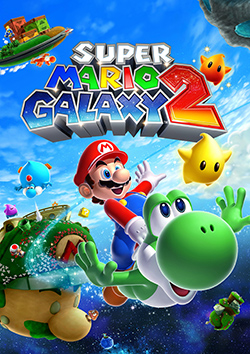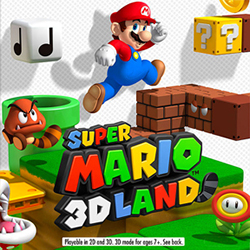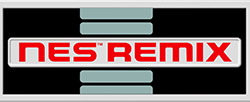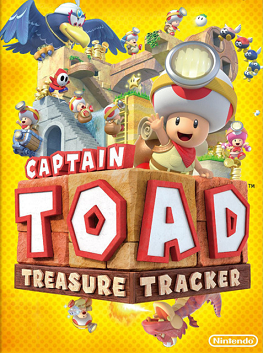
Shigeru Miyamoto is a Japanese video game designer, producer and game director at Nintendo, where he serves as one of its representative directors as an executive since 2002. Widely regarded as one of the most accomplished and influential designers in video games, he is the creator of some of the most acclaimed and best-selling game franchises of all time, including Mario,The Legend of Zelda, Donkey Kong, Star Fox and Pikmin. More than 1 billion copies of games featuring franchises created by Miyamoto have been sold.

Luigi is a character created by Japanese video game designer Shigeru Miyamoto. Part of Nintendo's Mario franchise, he is a kind-hearted, cowardly Italian plumber, and the younger fraternal twin brother and sidekick of Mario. Like his brother, Luigi's distinctive characteristics include his large nose and mustache, overalls, green hat, and high-pitched, exaggerated Italian accent.

Mario is a character created by the Japanese game designer Shigeru Miyamoto. He is the star of the Mario franchise, a recurring character in the Donkey Kong franchise, and the mascot of the Japanese video game company Nintendo. Mario is an Italian plumber who lives in the Mushroom Kingdom with his younger twin brother, Luigi. Their adventures generally involve rescuing Princess Peach from the villain Bowser while using power-ups that give them different abilities. Mario's distinctive characteristics include his large nose and mustache, overalls, red cap, and high-pitched, exaggerated Italian accent.

Super Mario Bros.: The Lost Levels is a 1986 platform game developed and published by Nintendo. A sequel to Super Mario Bros. (1985), it was originally released in Japan for the Family Computer Disk System as Super Mario Bros. 2 on June 3, 1986. Nintendo of America deemed it too difficult for its North American audience and instead released an alternative sequel, also titled Super Mario Bros. 2, in 1988. It was remade and renamed The Lost Levels for the 1993 Super Nintendo Entertainment System compilation Super Mario All-Stars, serving as its first international release. It has been rereleased for Game Boy Color, Game Boy Advance, Wii, Wii U, Nintendo 3DS, and Nintendo Switch.

The Legend of Zelda, originally released in Japan as The Hyrule Fantasy: Zelda no Densetsu, is an action-adventure game developed and published by Nintendo. The first game of The Legend of Zelda series, it is set in the fantasy land of Hyrule and centers on an elf-like boy named Link, who aims to collect the eight fragments of the Triforce of Wisdom in order to rescue Princess Zelda from Ganon. The player controls Link from a top-down perspective and navigates throughout the overworld and dungeons, collecting weapons, defeating enemies and uncovering secrets along the way.

Excitebike is a 1984 racing video game developed and published by Nintendo for the Nintendo Entertainment System. It was ported to arcades for the Nintendo VS. System later that year and Famicom Disk System in 1988. In North America, it became one of the best-selling games on the console. It is the first game in the Excite series.

Super Mario Galaxy is a 2007 platform game developed and published by Nintendo for the Wii. It is the third 3D platformer game in the Super Mario series. As Mario, the player embarks on a quest to rescue Princess Peach and save the universe from Bowser, after which the player can play the game as Luigi for a more difficult experience. The levels consist of galaxies filled with minor planets and worlds, with different variations of gravity, the central element of gameplay. The player character is controlled using the Wii Remote and Nunchuk and completes missions, fights bosses, and reaches certain areas to collect Power Stars. Certain levels also use the motion-based Wii Remote functions.

Super Mario is a platform game series created by Nintendo starring their mascot, Mario. It is the central series of the greater Mario franchise. At least one Super Mario game has been released for every major Nintendo video game console. However, there have also been a number of Super Mario video games released on non-Nintendo gaming platforms. There are more than 20 games in the series.
Kishōtenketsu (起承転結) describes the structure of many classic Chinese, Korean and Japanese narratives. Kishōtenketsu is sometimes described as a narrative structure devoid of conflict, particularly when compared to common Western narrative structures.
indieszero Corporation, Ltd. is a small video game development company headquartered in Musashino, Tokyo, Japan. It was founded on April 21, 1997, and has developed video games for other video game companies, including Nintendo, SEGA, and Square Enix.

Super Mario Galaxy 2 is a 2010 platform game developed and published by Nintendo for the Wii. It was first announced at E3 2009 and is the sequel to 2007's Super Mario Galaxy. Much like the first game, the story follows Mario as he pursues the Koopa King, Bowser, into outer space, where he has imprisoned Princess Peach and taken control of the universe using Power Stars and Grand Stars. Mario must travel across various galaxies to recover the Power Stars in order to travel to the center of the universe and rescue Princess Peach.

Toad, known in Japan as Kinopio, is a character created by Japanese video game designer Shigeru Miyamoto for Nintendo's Mario franchise. A prominent red Toad serves as one of Princess Peach's handlers and appears consistently as a supporting character in the franchise.

Super Mario 3D Land is a 2011 platform game developed and published by Nintendo for the Nintendo 3DS. It was released worldwide in November 2011, being the first Mario game to be released for the 3DS.

Luigi's Mansion: Dark Moon is a 2013 action-adventure video game developed by Next Level Games and published by Nintendo for the Nintendo 3DS. It is the sequel to the 2001 GameCube game Luigi's Mansion, and the third Mario franchise game where Luigi plays the lead role instead of the usual protagonist, Mario. The story follows Luigi as he explores Evershade Valley, capturing ghosts using a specialized vacuum cleaner invented by Professor E. Gadd. In order to restore peace to Evershade Valley, Luigi must collect the pieces of the Dark Moon and recapture the main antagonist, King Boo.
Pilotwings is a series of flight simulation video games beginning with the 1990 video game Pilotwings and most recently Pilotwings Resort in 2011. One of Nintendo's franchises, the series was released on the Super Nintendo Entertainment System, Nintendo 64, and Nintendo 3DS.

Rosalina, known as Rosetta (ロゼッタ) in Japan, is a character in the Mario franchise. She debuted in Super Mario Galaxy (2007), as a non-player character who resides in the Comet Observatory, the game's hub world. In the game, Rosalina is the adoptive mother of the Lumas, a fictional species of star-like creatures, and also watcher of the cosmos. Rosalina has since appeared as a player character in subsequent Mario games, such as the Mario Kart, Mario Party, and Super Smash Bros. series, as well as Super Mario 3D World. She also appears in Mario + Rabbids Sparks of Hope (2022), where she is possessed by Cursa, the main antagonist.

Super Mario 3D World is a 2013 platform game developed and published by Nintendo for the Wii U. It is the sixth original 3D platform game in the Super Mario series and the sequel to Super Mario 3D Land, a 2011 title for the Nintendo 3DS. The game was also re-released for the Nintendo Switch in Super Mario 3D World + Bowser's Fury on February 21, 2021.

NES Remix is a compilation video game series developed and published by Nintendo for the Wii U. The first and eponymous game was simultaneously announced and released on December 18, 2013, on the Nintendo eShop following a Nintendo Direct presentation. A second game, NES Remix 2, was released on April 25, 2014. A retail edition consisting of both games, titled NES Remix Pack, was released on April 24, 2014, in Japan and December 5 in North America. Another title, Ultimate NES Remix for Nintendo 3DS, was released on November 7–8, 2014 in Europe and Australia, December 5 in North America and August 27, 2015, in Japan.

Captain Toad: Treasure Tracker is a 2014 action puzzle video game developed and published by Nintendo for the Wii U. The game was re-released for the Nintendo Switch and Nintendo 3DS in 2018 with additional content. It is a spin-off of the Super Mario series and a part of the larger Mario franchise. The game stars Captain Toad and Toadette as they complete levels, defeat enemies and save each other from the antagonist Wingo. Each level is contained within a miniature diorama-like environment that requires puzzle-solving and platforming challenges to complete. The player also uses the Wii U GamePad to rotate the camera and reveal new information and interact with the environment.















